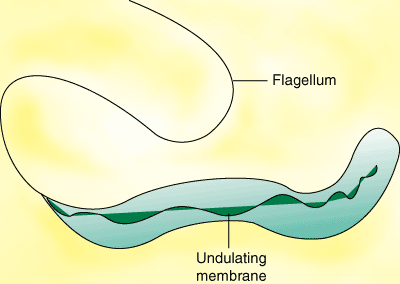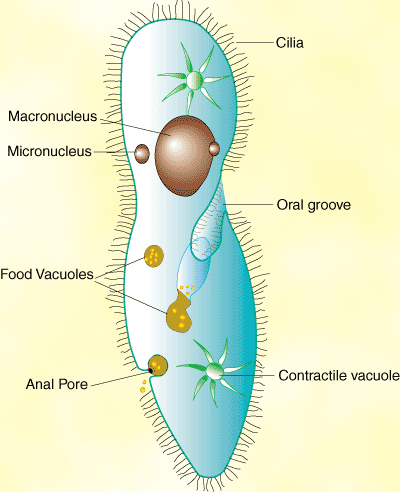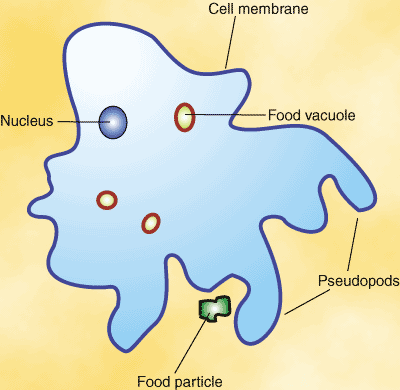Protozoa are the animal-like protists. These unicellular eukaryotes lack cell walls. They are heterotrophic and feed on other microorganisms or on organic particles. Protozoa ingest their food in two ways. The first is a process called phagocytosis, in which a flexible portion of the cell membrane surrounds a food particle and engulfs it, bringing it into the cell in a vacuole. Phagocytosis is used to ingest other unicellular organisms or large particles. Smaller particles are ingested by pinocytosis. In this process, the particle is sucked into an invagination in the cell membrane, which then folds in on itself and pinches off from the cell membrane to become a smaller vacuole.
Protozoa are highly motile. The method by which they move can be used to group them into three types: kinetoplastids, ciliates, and sarcodina.
Kinetoblastids
The kinetoplastids move by means of one or more eukaryotic flagella. Eukaryotes and prokaryotes both have structures called flagella, but they are structurally and evolutionarily distinct. Many kinetoplastids function parasitically in animals, though some are free-living.
A Typical Kinetoplastid: Trypanosoma gambiense
Trypanosoma gambiense is a kinetoplastid that is parasitic in humans, and
causes African sleeping sickness.

Ciliates
Ciliates move by means of rows of cilia. These hair-like structures are connected at their bases to a system of contractile fibers similar to a muscular system in higher animals. This allows the cilia to beat in a given pattern, either to move the cell or to wash food particles toward a primitive mouth.
A Typical Ciliate: The Paramecium

The structure of the paramecium is shown in the figure above. The cell membrane is covered with rows of cilia that beat rhythmically to wash food toward the oral groove where it will be packaged in special food vacuoles for digestion. Like all ciliates, and unlike any other group of protozoa, the paramecium has two types of nuclei. The macronucleus maintains cell growth and function by producing messenger RNA and can have hundreds of copies of the cell's DNA. The micronucleus is involved in inheritance of genetic material during sexual reproduction and is only diploid.
Sexual reproduction takes place through a process called conjugation. When individuals of opposite mating types meet, the adhere to each other at the oral groove. The micronuclei then divide meiotically, producing four haploid nuclei each. All but one nucleus from each paramecium disintegrate. The macronucleus also disintegrates, leaving each cell with one haploid micronucleus. These remaining nuclei then divide mitotically and the two cells swap copies of their nuclei. The cells separate and the haploid nuclei fuse, leaving each cell with a new diploid micronucleus. To form a new macronucleus, the micronucleus divides several times and the resulting nuclei develop into a macronucleus.

Sarcodina
Sarcodina have no flagella or cilia. They move by means of ameboid motion. Helped by filaments of a structural protein called actin, the cytoplasm of these protozoa can flow beneath the cell membrane into new branches called pseudopods, causing the cell to move in a given direction. Many sarcodina are parasites of the intestinal track and oral cavity of humans and other vertebrates. We are most familiar with the formless genus Ameba seen in , but many sarcodina secrete hard silica- or calcium carbonate-based shells, sometimes in elaborate, species-specific shapes. Shells made of calcium carbonate have been significant in forming many of the world's limestone deposits.



 payment page
payment page



